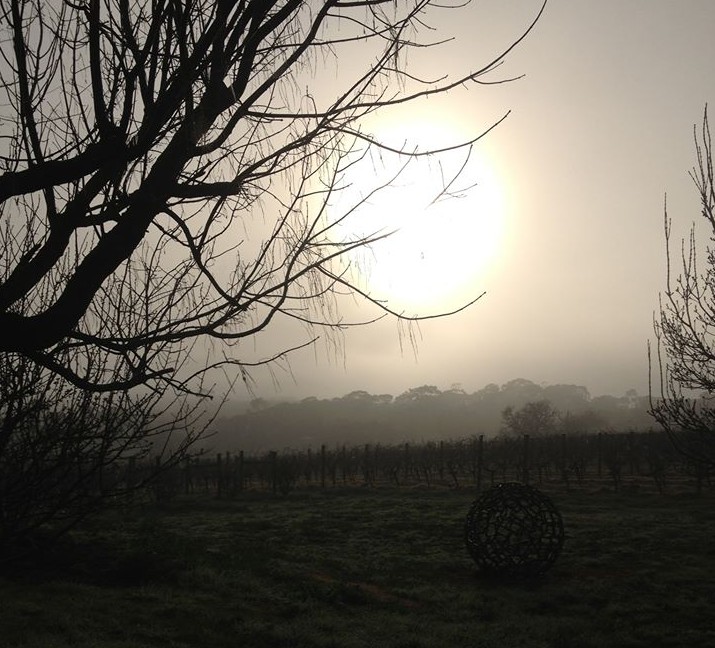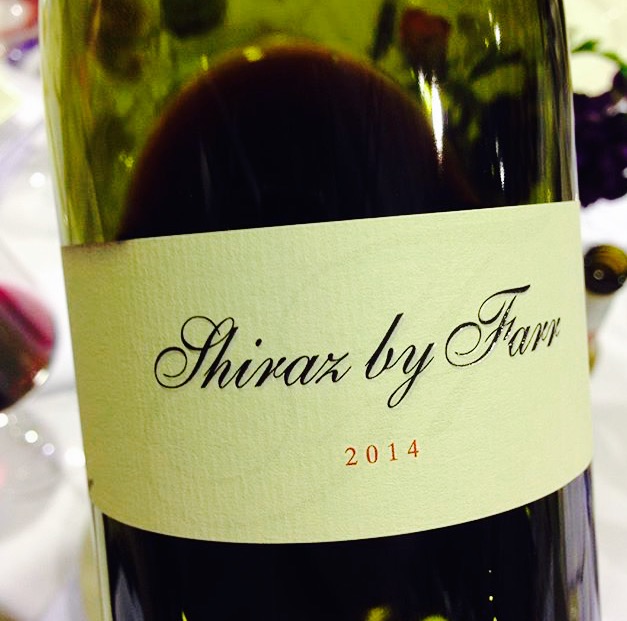
“This is another Pinot masterpiece from the experienced hands of [Nick] Farr,” wrote Nick Stock a few weeks back. This was in a tasting report on the Geelong region. The 2013 Tout Près came top, and the 2014 Chardonnay by Farr – the immediate predecessor to this release, labelled “immaculate” by Campbell Mattinson – came second. Every other wine by Farr and Farr Rising came equal fourth or fifth.
Nick Stock went on to ponder why the likes of Nick Farr “can consistently make some of the greatest Pinot Noir wines in the entire country and yet many others in this region struggle to get on the map”. The reason, it turns out, is that it just ain’t that easy; the Farrs happen to be off-the-chart gifted and their vineyard sites are awesome. Year in, year out, the now-famous sites of Sangreal and Farrside give their beguiling recital: ripe, resonant fruit, ethereal top notes and bass tones throbbing with the echo of the hungry local soils.
The 2014 growing season chez Farr got off to a fast and furious start, before spring turned cold, wet and windy. This meant a prolonged flowering period with poor fruit set and lower potential yields. A couple of heat waves had passed through by January and summer was warm overall. Harvest begun early but with the vines in excellent health and holding their acidity.
“It wasn’t great to see empty vats in the winery but the quality of the fruit was great,” says Nick. The yields were down 40% which is comparable to 2002 and 2007 yet the flavours of 2014 where far more complex, deep and longer perhaps because of extra week the fruit spent on the vine.” The result is wines that will age gracefully, with the concentration that comes with smaller harvests.
Nick Stock wrote of how the previous rendition of Chardonnay by Farr “really holds the finish with impressive pithy power; great wine”. The 2015 whites here bristle with that same energy and class. And completing this line-up of new releases is another 2014 red – a wine that could almost be called the best-kept secret, if it weren’t for the fact that everyone knows how good it is: Shiraz by Farr.
So how do the Farrs do it? Well, luck doesn’t come into it. Nothing at by Farr is by chance. When he planted these sites, Gary Farr knew the lie of the land and was hell-bent on producing great wine. The vineyards are now better than ever, and the Farr fire burns ever brighter.

THE WINES
2015 Viognier by Farr RRP $69
The By Farr Viognier is a blend of two vineyards. One is the original house block planted in 1994, which has friable red soil over limestone leading to sandstone—similar soils to the Sangreal Pinot Noir and By Farr Chardonnay. The second vineyard is a younger planting of unknown clones in red ironstone soil. The Viognier is a difficult variety to manage, with the tendency to grow horizontally rather than vertically, being very thirsty and having a tendency to become sunburnt very easily. This prompted Nick’s decision to pick the fruit earlier to retain natural acidity while maintaining varietal character, creating a more delicate and refined drink.
Viognier is foot-stomped and left for two or more hours on its skins, to extract phenolics, flavour and texture. The fruit is then pressed, cooled and put straight into barrel with all solids for a natural fermentation. Malolactic fermentation is encouraged with gentle stirring during the end of autumn. The wine is then racked, fined, filtered and bottled 11 months after harvest.
A lovely perfumed, yet subtle expression of viognier. Fresh peach and apricot flavours as a young wine, which we believe will intensify over time. The palate is restrained, luscious and shows a ginger-flavoured freshness with underlying power and lingering aftertaste. This wine benefits beautifully from 12 months of bottle ageing, as the acid softens. – Nick Farr
2015 Three Oaks Chardonnay by Farr RRP $82.50
The Chardonnay by Farr comes from the same site as the Sangreal Pinot Noir. It’s an exposed, hungry north-facing slope of red soil over limestone, planted in 1994. The Chardonnay vines are a mixture of Dijon clones and P58.
The fruit is picked by hand and whole-bunch pressed. All the solids are collected and chilled before being put to French oak barrels (30% new). A natural fermentation occurs over the next two to three weeks at cool temperatures. After fermentation, a bit of stirring helps start malolactic fermentation, which is usually completed by mid-spring. The wine is then racked, fined and lightly filtered before bottling 11 months after picking.
The trademark characteristics of the wine produced on this site are understated power and length with a mineral finish. The wine has a great fruit expression that is well integrated with French oak. The soil characteristics come through in the style of wine we have today. The palate is fine but firm, with great acidity, texture and length. This wine is rich in flavour, yet very refined. – Nick Farr
2014 Farrside by Farr RRP $86
The Farrside vineyard consists of black volcanic soil over limestone on a northeast-facing slope. The vine rows run east to west to shade the fruit from over exposure. It’s a mixture of 114, 115, 777, 667 and MV6 clones. Although the Farrside and Sangreal vineyards are only 300m apart, the differing conditions means that this vineyard is picked 10 to 12 days later. The darker soils and cooler growing conditions give a more masculine and edgy wine.
The fruit is hand-picked and sorted in the vineyard, then fermented in an open-top fermenter. Between 40 to 50% of the fruit will be destemmed and then cold soaked for four days. Nick uses only the natural yeast for the fermentation process, which takes roughly 12 days. Grape-stomping (known as pigeage) will occur two to three times a day depending on the amount of extraction required, and the wine is then placed in 50 to 60% new Allier barrels by gravity. It is racked by gas after secondary fermentation, then again at 18 months to be bottled.
Each vintage of Farrside pinot noir exhibits more masculinity, structure and savoury components, while deep meaty, spicy and mineral flavours also continue to evolve. A balanced array of red and black fruits, Farrside pinot noir is fresh and edgy with bucketloads of character. This is a firm yet delicate wine with a long-textured finish. – Nick Farr
2014 Sangreal by Farr Pinot Noir RRP $86
The Sangreal Vineyard is the oldest planting (1994) on a north-facing slope of red ironstone on the surface going to limestone to bluestone below. The rows run north to south, gaining full sun exposure throughout the day and resulting in prettier, more perfumed wines. It’s always the first vineyard to be harvested.
Sangreal is consistently made with 60 to 70% whole bunch and aged in new oak. It is fermented in a five-tonne oak barrel with an open-top fermenter, and cold soaked for four days before a natural fermentation of seven to nine days. Once the cap falls, the tank is pressed. The wine is racked only once after malolactic fermentation, then sulphured and bottled, the entire process taking a total of 18 months. The wine is unfined and unfiltered in order to retain its natural flavour and bouquet. Sangreal is the most seamless and perfumed of the three single-vineyard Pinots.
Clones 114 and 115 planted ’94, believed to have mutated into a single ‘Sangreal‘ clone. Always made with 50-70% whole bunches, and 60-70% new oak maturation for 18 months. Typical bright, deep hue; the bouquet exudes flowers (roses, violets), spices and a throbbing heartbeat of gently savoury dark fruits; the palate magically twists all these characters into a single silver-coated stream of red and blue fruits, the tannins no more than background haze, oak a slender frame. A gorgeous pinot of the highest category. 97 points. James Halliday
2013 Tout Près by Farr RRP $115
Tout Près is the family’s most special, intriguing site. Only a touch over 2.5 acres, it has three individual soil types across a three-sided cirque (an amphitheatre-like valley head) that rises above the other vineyards. Each slope consists of a soil type. The largest slope is black volcanic soil of limestone, the second is quartz gravel mixed with red ironstone soil and the third, an iron strand in grey sandy loam. The clones that will acclimatise and mutate over time are currently 113, 114, 115, 667, 777 and MV6 to become the Tout Près clone.
At 7,300 vines per hectare, Tout Près is the most densely planted vineyard on the estate (hence the name, meaning “very cosy”). The soils and intense competition force the vines to work hard, resulting in fruit that is lush but masculine and provides the coveted structure found only in the most ageworthy wines.
Tout Près is made in the same way as the other two Pinots. It is fermented with 100% whole bunches in a five-tonne oak fermenter. This wine has the flavour profile and intensity to absorb 100% new Allier French barrels.
This is another pinot masterpiece from the experienced hands of Gary Farr. Super concentrated and commanding, it has the classic iron fist in a velvet glove style of powerful elegance. The nose is composed and fragrant with rich dark cherry fruits, bergamot, fresh foresty aromas and cola; oak is beautifully integrated. The palate has impeccable balance from start to finish. Dense and yet silky, tannins build evenly and the wine flows effortlessly, delivering dark spiced cherry flavor with essence-like concentration. This has all the class of Grand Cru Burgundy. Drink now and for up to 10+ years. 97 points. Nick Stock, jamessuckling.com
2014 Shiraz by Farr RRP $69
Shiraz fruit comes from the original By Farr vineyard, planted in 1994. It lies on a north-facing slope, and the red volcanic soil has a base of limestone with deep-set sandstone.
All fruit is hand-picked from the VSP trellising, with 20% left as whole bunches in the fermentation. Most years we co-ferment between 2 and 4% Viognier with the Shiraz, the date determining whether or not the former is co-fermented and bled back. It is a natural fermentation, with the fruit remaining in the tank for 19 days before pressing. Shiraz sees 18 months in French oak, 20% being new, and is bottled under vacuum.
A powerful nose, with the depth and complexity of cool-climate shiraz. This wine is spiced with pepper and mineral elements, leaning towards earthy. The co-fermented viognier adds a little richness to both the bouquet and palate, which has a very pleasant sweetness to start, followed by intense fruit and earthy long tannins to complete the delicate structure and overall elegance of the wine. – Nick Farr